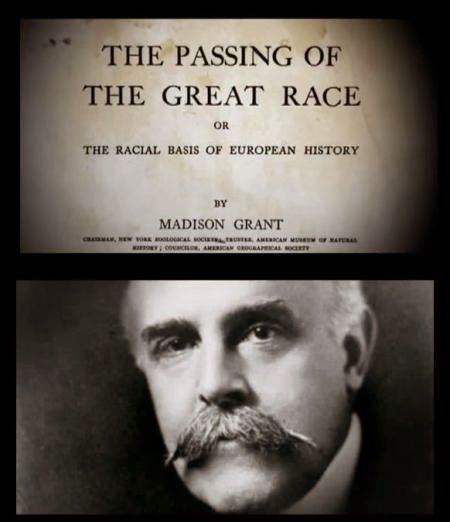The myth of racial and moral purity: a treatise on fascism
Cover photo: A poster from the 1930s by the Eugenics Society, courtesy of Wellcome Library.
By Tatiana Prophet
“fas·cism | \ ˈfa-ˌshi-zəm also ˈfa-ˌsi- \ a political philosophy, movement, or regime (such as that of the Fascisti) that exalts nation and often race above the individual and that stands for a centralized autocratic government headed by a dictatorial leader, severe economic and social regimentation, and forcible suppression of opposition.”
The word “fascism” has been used generously in the public square in the last few years – with many people accusing their political opponents of being “fascist” in their beliefs — usually because there is a perception or reality that they seek to impose those beliefs upon others.
What is the origin of the word “fascism”? It dates back to the Roman Empire, when those who enforced the law were portrayed in bas relief holding a bundle of sticks resembling a poster case, with an axe affixed to it. A fascio is a bundle, or “league.” The word predates Benito Mussolini even in modern Italy, as many groups including labor unions used the word to apply to a “league.”
Historians characterize Mussolini’s intent for the word “bundle” as representing unity with strength (hence the axe). There is even a “fascio” on either side of the top dais in the United States House of Representatives (decorated with laurel).
Merriam Webster defines fascism this way:
fas·cism | \ ˈfa-ˌshi-zəm also ˈfa-ˌsi- \ a political philosophy, movement, or regime (such as that of the Fascisti) that exalts nation and often race above the individual and that stands for a centralized autocratic government headed by a dictatorial leader, severe economic and social regimentation, and forcible suppression of opposition.
Robert O. Paxton, in “The Five Stages of Fascism” ( The Journal of Modern History, 1998) wrote: “Fascism is a system of political authority and social order intended to reinforce the unity, energy, and purity of communities in which liberal democracy stands accused of producing division and decline.”
And in his later book, “The Anatomy of Fascism” (Vintage Books, 2005), Paxton added a component of an obsession with victimhood and the “uneasy but effective” collaboration by a mass-based party of militants with the “traditional elites.”
Obsession with societal decay, victimhood, and racial or national purity are common themes among the governments that went “full fascist.” In the case of Nazi Germany, the perceived victims were the “German people” (except Jewish Germans), and the scapegoats were Jews worldwide.
Often the Jewish community was blamed for local atrocities that were actually the result of ideological struggles between Communists and Fascists. In 1940 in Ukraine, reeling from Soviet authoritarianism, the Nazis’ Operation Barbarossa had surprised the Soviets, whereupon the Soviet interior ministry, the NKVD, which had recently filled their prisons with political prisoners, massacred fully two-thirds of them (about 100,000), and forced the others on death marches as they fled the Nazis. Left behind were uninformed family members who rushed to the prisons to free their loved ones, only to find their bodies heavily mutilated, according to Robert Gellately in “Lenin, Stalin and Hitler: The Age of Social Catastrophe,” (Knopf, 2007).
The Nazis documented the massacres in film and photographs designed as anti-Jew and anti-Soviet propaganda — which only reinforced a belief among Ukrainians that Jews were responsible for propping up the Bolsheviks and later the Communists.
This led to Ukrainian nationalists in Lvov, led by Stepan Bandera, whipped up by the Nazis, to hunt down Jews and massacre them.
A Jewish woman being chased during the pogrom of Lvov in July 1941 (occupied Poland).
Numerous photos exist of the Lvov pogrom, which killed up to 7,000 Jews in the span of a month. Police officers and citizen militias with blue and yellow armbands, the colors of the flag of Ukraine, whipped up the crowd in a carnival-like atmosphere as they tore the clothes off women, beat elderly Jews, hunted all of them down and then left them to be shot by the Nazis.
The concept of racial and moral purity did not start with Adolf Hitler and the Nazis; in fact, it came from the United States and its once-wildly popular eugenics movement. There was “The Blood of the Nation” written in 1901 by David Starr Jordan, the president of Stanford University. It was published in Popular Science and then republished by the American Unitarian Association. Jordan contended that wars caused genetic decay because of the absence of fathers, among other things. (It doesn’t take the president of Stanford — or a racist mindset — to figure out that wars are bad for those who fight them.)
In 1916, New York lawyer and conservationist Madison Grant published “The Passing of the Great Race” (Charles Scribners & Sons), in which he put forth the pseudoscience of Nordic racial superiority. Adolf Hitler actually wrote to Grant and called the book “My Bible” (Stefan Kühl, “Nazi Connection: Eugenics, American Racism, and German National Socialism. Oxford University Press, 2002). Those were by no means the only books on the topic.
America’s interest in moral and racial purity coincided with the screening of “Birth of a Nation” at the White House under President Woodrow Wilson, and a resurgence in membership in the Ku Klux Klan. The film portrays blacks and black men in particular as morally inferior with base desires that threaten the purity of the white female, and holds up the Klan as a way to protect the nation.
Adolf Hitler wrote the author, New York lawyer Madison Grant, to tell him that the book was “My Bible.” Grant was one of the founders of the American Eugenics Society in 1921. The organization is now called the Society for Biodemography and Social Biology.
Grant advocated for lower immigration as well as the sterilization of the “feebleminded.” According to the Virginia Sterilization Act’s definition of feeblemindedness, there were three levels of feebleminded: morons, imbeciles and idiots, all in descending order of awareness (The Embryo Project Encyclopedia, 2012).
It was in this milieu that Supreme Court Justice Oliver Wendell Holmes famously wrote: “Instead of waiting to execute degenerate offspring for crime, or to let them starve for their imbecility, society can prevent those who are manifestly unfit from continuing their kind. … Three generations of imbeciles are enough.”
The American public began to turn away from eugenics by the 1930s as Hitler’s fascist state began to take shape. By the end of World War II, most Americans rejected the idea of eugenics as abhorrent in light of the liberated Nazi death camps, and anathema to the belief that the American dream can be achieved by anyone willing to work hard enough.
But sterilization continued in various jurisdictions, in institutions and prisons around the United States.
And even if eugenics became unpopular, it left a lasting scar on the nation when it came to the integration of black Americans. It wasn’t enough that they had already contended with vicious propaganda in literature, music and everyday life as part of the “minstrel” shows. They were going to have to wait another generation before receiving the full rights of citizenship to go where they pleased and patronize whatever business they chose. The resurgence of racism in the early 20th Century was a big part of setting back American blacks yet again after the devastation of late-19th Century Jim Crow laws (barring them from running for office among other things).
The era of Prohibition was another example of obsession with moral decay as being the root of society’s ills. And it was a painful lesson that pointing fingers at any one failing is not going to solve the wasting away of the hopeless masses.
Whatever it is in theory and practice, fascism is an effective way to hide the true causes of poverty and suffering – a deflection by those powerful people who are truly cutthroat enough to want to perpetuate poverty, starvation, suffering and death — as long as they profit from it.
When there is an obsession with moral decay, the myth of racial or national purity and victimhood bolstered by the corresponding propaganda, the people of earth will be susceptible to the division that causes so much destruction.
The jump to denounce certain groupings of our fellow man as the cause of our collective woes is shockingly prevalent in our world; and yet we must realize at some level that being incorrect in our judgments could lead to disastrous consequences. Add to that a fear that we will fall into the same descipable lot as previous hoodwinked populations, and our psyches are stressed to the breaking point.
Rather than any sort of physical, mental or theological impurity, society’s ills are often caused by the lack of will to enforce the law with the transparency and courage that is required to guard against cronyism and corruption.
Pretending that corruption does not exist is the ultimate deflection by a ruling class that is anything but transparent — in spite of all their protestations.
The word “fascio” meaning “bundle,” i.e. “grouping” is actually appropriate because at its core, we are dealing with the “in-group” and the “out-group.” The “in-group” commits crimes with impunity; the “out-group” gets the book thrown at them.
What we have witnessed, in cyclic waves throughout recorded history, is less “moral decay,” and more predator versus prey. The predator lies, divides, and thrives at the expense of the prey.
That is the old way of blood fueds, tribalism and slavery. Ironically, Genghis Khan ended the practice of blood feuding among the Mongols and codified the law, allowing plurality of culture and religion to be practiced in his khanate. If we have different laws for different groups (fasci), we are actually returning to tribalism where if you are in the out-group your life means absolutely nothing. That is true fascism (“tribalism,”), and there is nothing pure about it.
Without propaganda, fascism cannot exist. Therefore to recognize fascism, and become an integrated human race in all its glorious plurality, we MUST have true transparency. In trying to right wrongs, seek justice, and make the world a better place, we’ve often run into fascism as the powers seek to bend the truth to their advantage. But fascism, while attractive, is not a subsitute for truth. It is always a lie.
That is why the pursuit of facts — complete facts — is a prerequisite to freedom. And freedom is the true polar opposite of fascism. Won’t you join me in the pursuit of freedom through complete facts? It’s liberating, I tell you!








